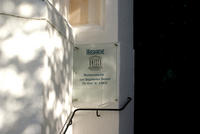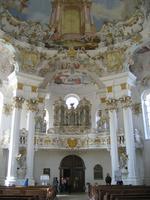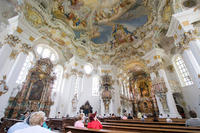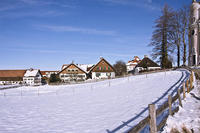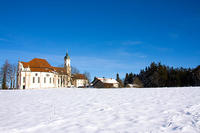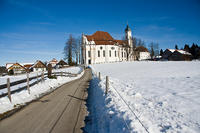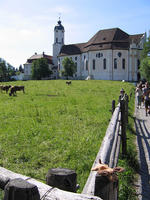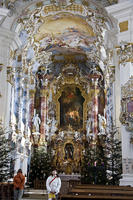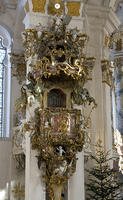You are in: Europe -> Germany -> Pilgrimage Church of Wies, and traditional search or Image Gallery will yield results of this site only
Pilgrimage Church of Wies
| Site number: | 271 |
|
| Type of site: | Cultural | |
| Date: | 1745–54 | |
| Date of Inscription: | 1983 | |
| Location: | Europe, Germany, State- Bavaria, Region- Upper Bavaria, Weilheim-Schongau District, Steingaden town | |
Up to 75 images are shown here. Click on each for more details or on Image Gallery for more images.
| Description: | The Church of Wies has miraculously preserved in the beautiful setting of an Alpine valley. The church is a masterpiece of Bavarian Rococo– exuberant, colourful and joyful - created by the genius architect Dominikus Zimmermann in 1745–54. --WHMNet paraphrase from the description at WHC Site, where additional information is available. | |
| The pilgrimage church of Wies (German: Wieskirche) is an oval rococo church, designed in the late 1740s by Dominikus Zimmermann, who spent the last eleven years of his life in a nearby dwelling. It is located in the foothills of the Alps, the Steingaden municipality of the Weilheim-Schongau district, Bavaria, Germany. In 1738 tears were seen on a dilapidated wooden figure of the Scourged Saviour. This miracle resulted in a pilgrimage rush to see the sculpture. In 1740 a small chapel was built to house the statue, but it was soon realized that the building would be too small for the number of pilgrims it attracted, and thus Steingaden Abbey decided to commission a separate shrine. Many people who have prayed in front of the statue of Jesus on the altar have claimed that people have been miraculously cured of their diseases, which has made this church even more of a pilgrimage site. Construction took place between 1745 and 1754, and the interior was decorated in stuccowork in the tradition of the Wessobrunner School. "Everything was done throughout the church to make the supernatural visible. Sculpture and murals combined to unleash the divine in visible form"[1]. The church, commonly regarded as Zimmermann's final masterpiece, was secularized in the beginning of the 19th century. Subsequently, protests of local farmers saved this jewel of rococo architecture and design from being sold and demolished. The Wieskirche was added to the UNESCO World Heritage List in 1983 and underwent massive restoration in 1985-91. --Wikipedia. Text is available under the Creative Commons Attribution-ShareAlike License. | ||
| Source: | http://whc.unesco.org/en/list/271 | |
| Reference: | 1. UNESCO World Heritage Center, Site Page. | |








